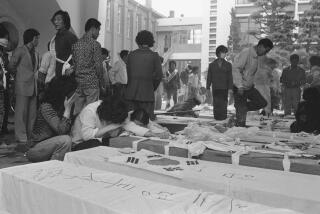Police Learn to Debug Forensic Methods
- Share via
STATE COLLEGE, Pa. — Investigators realized centuries ago that insects could help them solve murders.
In China, legend has it, authorities asked villagers to lay their tools in the sunlight after a slaying involving a sickle. Flies flew to one of the displayed tools, prompting a swift confession from its owner.
Scientific advances aside, that’s about how it works today. Police collect maggots, flies and beetles from a crime scene and send them to a forensic entomologist so he can pinpoint the time and location of death.
Trouble is, police aren’t scientists. They don’t always know what to collect and how to preserve the samples. Enter Penn State’s three-day course in forensic entomology.
Run by professor Ke Chung Kim, the goal is to show investigators how to collect crime-scene insects so the evidence will stick in court.
“Most of the cases that I get, they already got the material and they ask me, ‘What can you do with it?’ ” said Kim, who has taught the class annually for seven years. “Most investigating agencies cannot or do not employ a forensic entomologist. So the best thing to do is train these guys.”
This year’s class, held in May, began with a visit to the pigs. Kim’s assistant took dead pigs to woods on the outskirts of campus. He laid them on the grass, one in the sun and two others under trees.
Within 10 minutes, the first flies arrived to lay their eggs.
“When a body dies, there are chemical changes that occur almost instantaneously,” said R.P. Withington III, the assistant. “And the bugs pick up on that almost as quickly.”
On the first day of class, 13 prosecutors, police officers, coroners and state troopers filed into the woods behind Kim. Law enforcers from as far away as New York City, Oklahoma and Virginia attended.
The stench was all too familiar to career investigators. A few steps farther and they came to a decomposing body, sprawled out and crawling with maggots and beetles.
The group peered down at the crawling mass. One of them took photographs. A day later, they collected samples, preserved them in alcohol and returned them to a laboratory for closer inspection.
What the students take away from the class are the nuances of forensic entomology. The scientists want to know how many bugs were on the body and where they were found. But they also need to know about weather conditions, the humidity, the temperature of the insect masses. They might also want dirt samples.
“When you come to this class, you find out what you didn’t collect,” said Joe Taussi, an investigator in the Middlesex County, N.J., prosecutor’s office. “You’re like, ‘Wow, I should have done that, I didn’t do that.’ ”
With complete information, entomologists can figure out how long the insects were alive--which tells them how long the person was dead. Their estimates are frequently more precise than coroners’ reports, which rely on body heat.
“It is not really an exact science,” Kim said. “But decomposition has definite stages. All we are doing is applying knowledge of insects to societal problems.”
Kim testified in 1990 in an Erie, Pa., murder trial. His estimate of the time of death contradicted the coroner’s report and fell in a two-hour window for which the suspect had no alibi. The suspect later confessed.
Kim can repeat that success only if investigators collect samples correctly. Many don’t.
Investigators have sent him dry, shriveled insects. One autopsy report indicated thousands of maggots; Kim received exactly three. Another vial, slipped into an unpadded envelope, arrived shattered.
But most investigators know that insects can pay dividends when they are processed correctly. A Rutgers University entomologist examined samples from one corpse for Taussi’s office and reported a time of death that eliminated the suspect’s alibi.
“Science is very powerful,” Taussi said. “Most times, people are in awe. They say, ‘These people must know what they’re talking about, they’re scientists.’ And sometimes that’s all it takes in an interrogation. Sometimes it’s all you have, and doing it correctly makes a difference.”
More to Read
Sign up for Essential California
The most important California stories and recommendations in your inbox every morning.
You may occasionally receive promotional content from the Los Angeles Times.













